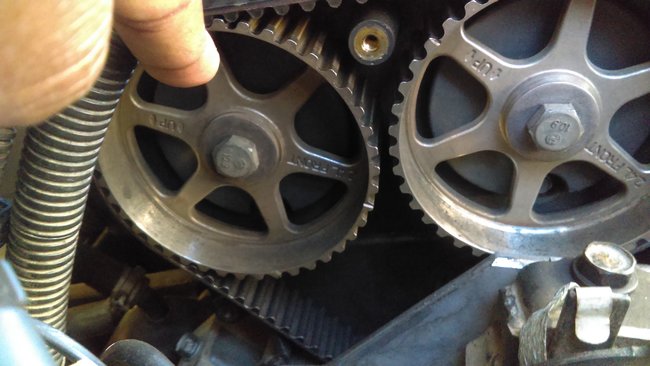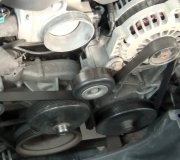When we had carburetors, blocking a vacuum leak resulted in reduced engine speed, so it was pretty obvious when we found it. With fuel injection, once the minimum throttle relearn has taken place, idle speed will be held constant by the Engine Computer, so we can't use engine speed for our observation. Instead, we can look at automatic idle speed "steps", but you need a scanner to do that. The computer pulses the automatic idle speed motor with varying polarities and voltages to place the armature at the desired setting. As the armature rotates slowly, it has a threaded shaft that retracts a pintle valve to open an air passage around the throttle blade. As it increases air flow, it also increases the length of time the injectors are pulsed on, so the engine gets more air and more fuel.
There are 256 steps the computer can set the AIS motor to. For a properly-running engine, step 32 is typical. With one misfiring cylinder on a V-6 engine, step 50 is about what you will find. When you have a vacuum leak and the resulting increased engine speed, the computer will close the AIS valve to bring idle speed back down, and you may find it at step 0 to step 10. If you find it is at step, ... Oh, ... 50, 60, or higher, the high idle speed is in response to something the computer is seeing from other sensors, and it is requesting that higher speed.
For your situation where the only symptom is the fault code and a lean condition detected by the computer, you can still use the idle steps to show if you change something that affects the air / fuel ratio. You don't have to search through every vacuum hose. There are only two or three origination points on the intake manifold for all the vacuum-driven stuff. One will be the large one for the power brake booster, and it will usually have a tap on the check valve for a hose to the cruise control servo. A leak in those hoses will usually include the symptom of hard brake pedal, or hard pedal after the first or second pedal application in rapid succession. For the smaller vacuum hoses, pinch one off near the intake manifold, then watch what happens to the idle steps. If you blocked a leak, the steps will need to go up to bring the idle speed back up. When you find a hose that appears to have a leak, follow it to where another hose branches off, then pinch each of them, one at a time, to see which one has the leak, then follow that one.
You can also watch the exhaust gas switching rate. It should be switching between "rich" and "lean" about two times per second. With a vacuum leak, it will tend to stay lean a lot more and it will only occasionally go rich. That will change when you block a vacuum leak.
Simple fault code readers don't provide sensor data. Some of the newer readers DO provide data, but they have a serious drawback. They take a reading, analyze it, then display the results for up to three to five seconds while they analyze the next set of readings. That major time delay makes it not very valuable for this type of problem. Professional scanners update their displays multiple times per second, so it is very unlikely you will miss a tiny glitch or change in a reading. Most scanners also have graphing capabilities. That makes looking for changes in air / fuel ratio real easy to spot. If you have a scanner that can graph up to four things at once, you can graph air / fuel ratio and manifold vacuum, and compare the times they change to see if one correlates with the other.
If you find your idle steps are close to normal, you may have a vacuum leak that is intermittent. Erase the fault code, then watch how long and under which conditions it sets again. For intermittent leaks, we tend to think of a cracked hose that opens up when the engine rocks during acceleration, but we forget that some circuits turn on and off at various times. Two of the more common ones are the EGR valve and the charcoal canister purge valve. The EGR valve will not turn on at idle or low engine speeds because that would cause a rough-running engine. The purge valve typically only opens at higher speeds where the increased fuel vapors entering the engine can be more easily compensated for by the computer. Both of those systems open up additional vacuum hoses when their valves open, and that may be the only time the leak shows up.
Friday, November 11th, 2016 AT 3:14 PM



